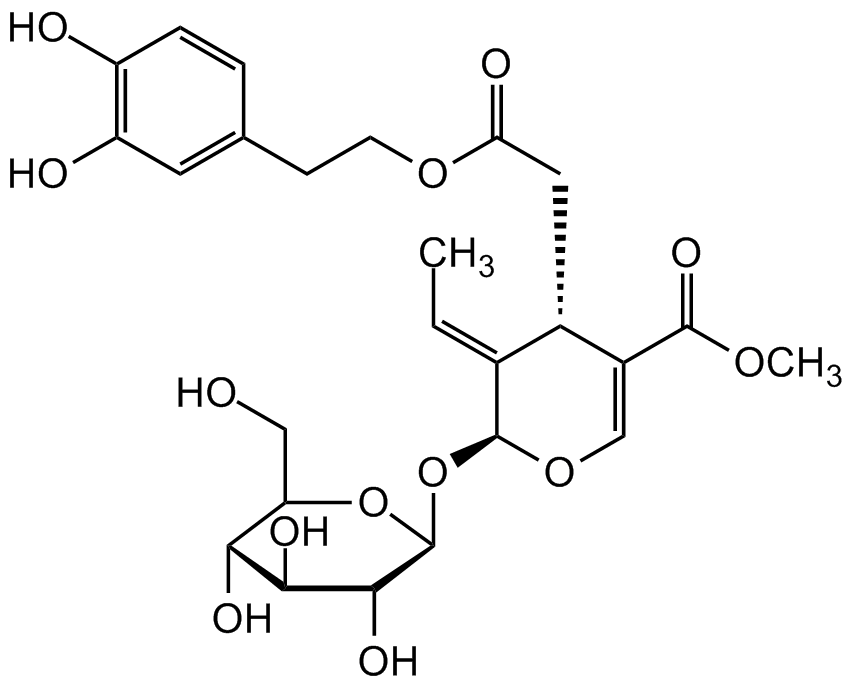
Chemical Structure
Oleuropein [32619-42-4]

AG-CN2-0538
CAS Number32619-42-4
Product group Chemicals
Estimated Purity>98%
Molecular Weight540.5
Overview
- SupplierAdipoGen Life Sciences
- Product NameOleuropein [32619-42-4]
- Delivery Days Customer10
- CAS Number32619-42-4
- CertificationResearch Use Only
- Estimated Purity>98%
- Molecular FormulaC25H32O13
- Molecular Weight540.5
- Scientific DescriptionChemical. CAS: 32619-42-4. Formula: C25H32O13. MW: 540.5. Oleuropein is a polyphenol from olive leaves and fruits that hydrolyzes to form hydroxytyrosol and tyrosol. Oleuropein exhibits antioxidant, anti-inflammatory, anticancer, antimicrobial, antifungal, antiviral, antiobesity, antidiabetic, antihypertensive, hypolipidemic, hepatoprotective and neuroprotective properties. Free radical-scavenging compound. Inhibits cell proliferation, cell growth, migration, invasion and angiogenesis and induces apoptosis and cell cycle arrest in cancer cells but not normal cells. Modulates gene expression and activity of a variety of different signaling proteins that play a role in proliferation and apoptosis. Induces autophagy by activating AMPK. Potential agent against metabolic syndrome. Reduces adipogenesis by antagonizing PPARgamma. Enhances UCP1 expression in brown adipose tissue in high-fat-diet-induced obese rats by activating beta-adrenergic signaling. Promotes beta cell insulin secretion and protects beta cells from amylin amyloid-induced cytotoxicity. Improves insulin resistance by promoting GLUT4 translocation. Inhibits expression of inflammatory mediators by suppressing the activation of NF-kappaB and MAPKs. HIV-1 fusion and integrase inhibitor. - Oleuropein is a polyphenol from olive leaves and fruits that hydrolyzes to form hydroxytyrosol and tyrosol. Oleuropein exhibits antioxidant, anti-inflammatory, anticancer, antimicrobial, antifungal, antiviral, antiobesity, antidiabetic, antihypertensive, hypolipidemic, hepatoprotective and neuroprotective properties. Free radical-scavenging compound. Inhibits cell proliferation, cell growth, migration, invasion and angiogenesis and induces apoptosis and cell cycle arrest in cancer cells but not normal cells. Modulates gene expression and activity of a variety of different signaling proteins that play a role in proliferation and apoptosis. Induces autophagy by activating AMPK. Potential agent against metabolic syndrome. Reduces adipogenesis by antagonizing PPARgamma. Enhances UCP1 expression in brown adipose tissue in high-fat-diet-induced obese rats by activating beta-adrenergic signaling. Promotes beta cell insulin secretion and protects beta cells from amylin amyloid-induced cytotoxicity. Improves insulin resistance by promoting GLUT4 translocation. Inhibits expression of inflammatory mediators by suppressing the activation of NF-kappaB and MAPKs. HIV-1 fusion and integrase inhibitor.
- SMILESOC1=C(O)C=CC(CCOC(C[C@H]2/C([C@H](O[C@H]3[C@H](O)[C@@H](O)[C@H](O)[C@@H](CO)O3)OC=C2C(OC)=O)=C\C)=O)=C1
- Storage Instruction-20°C,2°C to 8°C
- UNSPSC12352200
